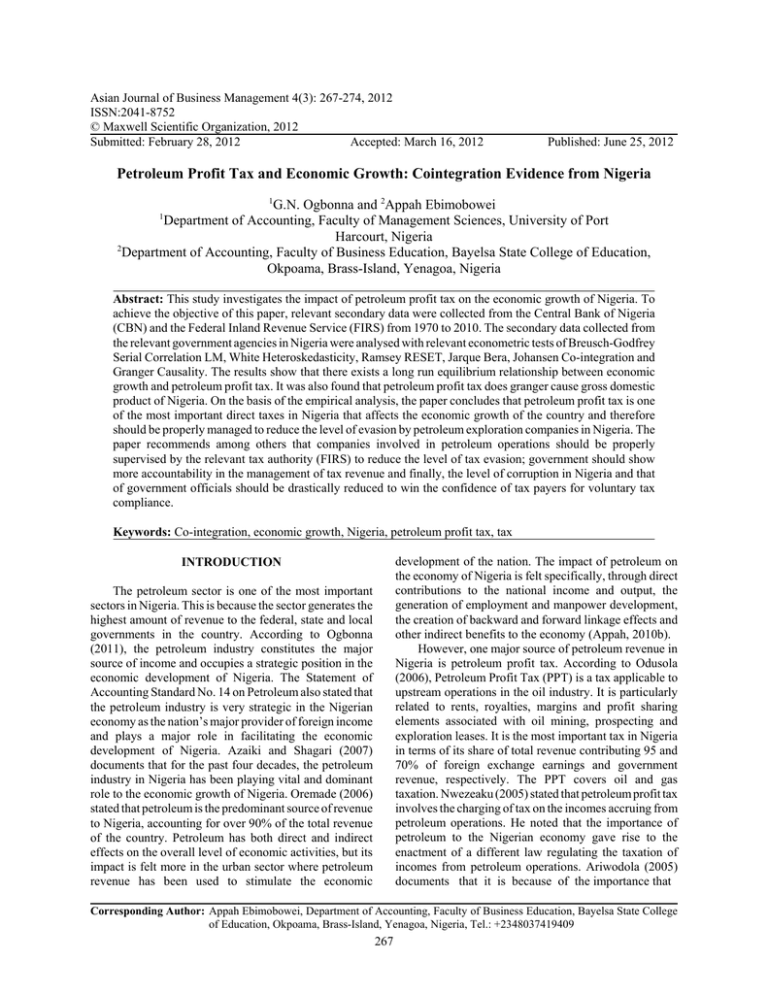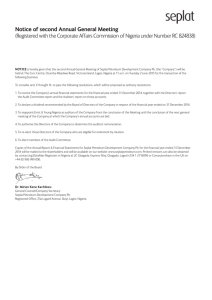Asian Journal of Business Management 4(3): 267-274, 2012 ISSN:2041-8752
advertisement

Asian Journal of Business Management 4(3): 267-274, 2012 ISSN:2041-8752 © Maxwell Scientific Organization, 2012 Submitted: February 28, 2012 Accepted: March 16, 2012 Published: June 25, 2012 Petroleum Profit Tax and Economic Growth: Cointegration Evidence from Nigeria 1 G.N. Ogbonna and 2Appah Ebimobowei Department of Accounting, Faculty of Management Sciences, University of Port Harcourt, Nigeria 2 Department of Accounting, Faculty of Business Education, Bayelsa State College of Education, Okpoama, Brass-Island, Yenagoa, Nigeria 1 Abstract: This study investigates the impact of petroleum profit tax on the economic growth of Nigeria. To achieve the objective of this paper, relevant secondary data were collected from the Central Bank of Nigeria (CBN) and the Federal Inland Revenue Service (FIRS) from 1970 to 2010. The secondary data collected from the relevant government agencies in Nigeria were analysed with relevant econometric tests of Breusch-Godfrey Serial Correlation LM, White Heteroskedasticity, Ramsey RESET, Jarque Bera, Johansen Co-integration and Granger Causality. The results show that there exists a long run equilibrium relationship between economic growth and petroleum profit tax. It was also found that petroleum profit tax does granger cause gross domestic product of Nigeria. On the basis of the empirical analysis, the paper concludes that petroleum profit tax is one of the most important direct taxes in Nigeria that affects the economic growth of the country and therefore should be properly managed to reduce the level of evasion by petroleum exploration companies in Nigeria. The paper recommends among others that companies involved in petroleum operations should be properly supervised by the relevant tax authority (FIRS) to reduce the level of tax evasion; government should show more accountability in the management of tax revenue and finally, the level of corruption in Nigeria and that of government officials should be drastically reduced to win the confidence of tax payers for voluntary tax compliance. Keywords: Co-integration, economic growth, Nigeria, petroleum profit tax, tax development of the nation. The impact of petroleum on the economy of Nigeria is felt specifically, through direct contributions to the national income and output, the generation of employment and manpower development, the creation of backward and forward linkage effects and other indirect benefits to the economy (Appah, 2010b). However, one major source of petroleum revenue in Nigeria is petroleum profit tax. According to Odusola (2006), Petroleum Profit Tax (PPT) is a tax applicable to upstream operations in the oil industry. It is particularly related to rents, royalties, margins and profit sharing elements associated with oil mining, prospecting and exploration leases. It is the most important tax in Nigeria in terms of its share of total revenue contributing 95 and 70% of foreign exchange earnings and government revenue, respectively. The PPT covers oil and gas taxation. Nwezeaku (2005) stated that petroleum profit tax involves the charging of tax on the incomes accruing from petroleum operations. He noted that the importance of petroleum to the Nigerian economy gave rise to the enactment of a different law regulating the taxation of incomes from petroleum operations. Ariwodola (2005) documents that it is because of the importance that INTRODUCTION The petroleum sector is one of the most important sectors in Nigeria. This is because the sector generates the highest amount of revenue to the federal, state and local governments in the country. According to Ogbonna (2011), the petroleum industry constitutes the major source of income and occupies a strategic position in the economic development of Nigeria. The Statement of Accounting Standard No. 14 on Petroleum also stated that the petroleum industry is very strategic in the Nigerian economy as the nation’s major provider of foreign income and plays a major role in facilitating the economic development of Nigeria. Azaiki and Shagari (2007) documents that for the past four decades, the petroleum industry in Nigeria has been playing vital and dominant role to the economic growth of Nigeria. Oremade (2006) stated that petroleum is the predominant source of revenue to Nigeria, accounting for over 90% of the total revenue of the country. Petroleum has both direct and indirect effects on the overall level of economic activities, but its impact is felt more in the urban sector where petroleum revenue has been used to stimulate the economic Corresponding Author: Appah Ebimobowei, Department of Accounting, Faculty of Business Education, Bayelsa State College of Education, Okpoama, Brass-Island, Yenagoa, Nigeria, Tel.: +2348037419409 267 Asian J. Bus. Manage., 4(3): 267-274, 2012 reduce income inequalities etc. The main purpose of purpose of tax is to raise revenue to meet government expenditure and to redistribute wealth and management of the economy (Ola, 2001; Jhingan, 2004; Bhartia, 2009). According to Nzotta (2007), four key issues must be understood for taxation to play its functions in the society. First, a tax is a compulsory contribution made by the citizens to the government and this contribution is for general common use. Secondly, a tax imposes a general obligation on the tax payer. Thirdly, there is a presumption that the contribution to the public revenue made by the tax payer may not be equivalent to the benefits received. Finally, a tax is not imposed on a citizen by the government because it has rendered specific services to him or his family. Thus, it is evident that a good tax structure plays a multiple role in the process of economic development of any nation which Nigeria is not an exception (Appah, 2010a). Musgrave and Musgrave (2006) note that these roles include: the level of taxation affects the level of public savings and thus the volume of resources available for capital formation; both the level and the structure of taxation affect the level private saving. A system of tax incentives and penalties may be designed to influence the efficiency of resource utilization; the distribution of the tax burdens plays a large part in promoting an equitable distribution of the fruit of economic development; the tax treatment of investment from abroad may affect the volume of capital inflow and rate of reinvestment of earnings there from; and the pattern of taxation on imports relative to that of domestic producers affect the foreign trade balance. However, Anyanwu (1993) pointed out that there are three basic objectives of taxation. These are to raise revenue for the government, to regulate the economy and economic activities and to control income and employment. Also, Nzotta (2007) noted that taxes generally have allocational, distributional and stabilization functions. The allocation function of taxes entails the determination of the pattern of production, the goods that should be produced, who produces them, the relationship between the private and public sectors and the point of social balance between the two sectors. The distribution function of taxes relates to the manner in which the effective demand over economic goods is divided, among individuals in the society. According to Musgrave and Musgrave (2006), the distribution function deals with the distribution of income and wealth to ensure conformity with what society considers a fair or just state of distribution. The stabilization of function of taxes seeks to attain high level of employment, a reasonable level of price stability, an appropriate rate of economic growth, with allowances for effects on trade and on the balance of payments. Nwezeaku (2005) argues that the scope of these functions depends, inter alia, on the political and government attaches to oil exploration and production that the taxation of profits or gains of companies engaging in such operations are taxable under the Petroleum Profit Tax Act of 2004 as amended. The oil and gas companies operating in Nigeria have not played the expected role to meet the economic development of Nigeria and the aspirations of the Niger Delta areas in particular. There has been buck-passing between the government and oil companies. While oil companies claim that they pay 85% petroleum profit tax which government is supposed to use in developing the country and the Niger Delta in particular, the government demands that oil companies ought to render corporate social responsibilities to their host communities that creates enabling environment for them to operate. The multinational companies extract so much value from Nigerian economy without commensurate pay-back in terms of the development of the economy. In most cases, they evade taxes, notwithstanding that they report good profits from operating in Nigeria (Ogbonna, 2011). Therefore, we need to know the impact of petroleum profit tax on the economic growth of Nigeria for the period 1970-2010. The objective of this research is to examine the impact of petroleum profit tax on the economic growth of Nigeria for the period 1970-2010. To achieve this objective, the paper is divided into five interconnected sections. The next section presents the literature review. The third section examines the materials and methods adopted in the research. The fourth section presents the results and discussion, while the final section presents the conclusion and recommendations. LITERATURE REVIEW Nature of taxation: According to Azubike (2009), tax is a major player in every society of the world. The tax system is an opportunity for government to collect additional revenue needed in discharging its pressing obligations. A tax system offers itself as one of the most effective means of mobilizing a nation’s internal resources and it lends itself to creating an environment conducive to the promotion of economic growth. Tax is a compulsory levy imposed on a subject or upon his property by the government to provide security, social amenities and create conditions for the economic wellbeing of the society (Appah, 2004; Appah and Oyandonghan, 2011). Anyanwu (1997) defined taxation as the compulsory transfer or payment (or occasionally of goods and services) from private individuals, institutions or groups to the government. Anyanfo (1996) and Anyanwu (1997) stated that tax are imposed to regulate the production of certain goods and services, protection of infant industries, control business and curb inflation, 268 Asian J. Bus. Manage., 4(3): 267-274, 2012 economic orientation of the people, their needs and aspirations as well as their willingness to pay tax. Thus the extent to which a government can perform its functions depend largely on the ability to design tax plans and administration as well as the willingness and patriotism of the governed. According to Anyanfo (1996), the principles of taxation mean the appropriate criteria to be applied in the development and evaluation of the tax structure. Such principles are essentially an application of some concepts derived from welfare economists. In order to achieve the broader objectives of social justice, the tax system of a country should be based on sound principles. Jhingan (2004), Bhartia (2009), Osiegbu et al., (2010) listed the principles of taxation as equality, certainty, convenience, economy, simplicity, productivity, flexibility and diversity. Equity Principle states that every taxpayer should pay the tax in proportion to his income. The rich should pay more and at a higher rate than the other person whose income is less (Jhingan, 2004). Anyanfo (1996) states that it is only when a tax is based on the tax payer’s ability to pay can it be considered equitable or just. Sometimes this principle is interpreted to imply proportional taxation. Certainty Principle of taxation states that a tax which each individual is bound to pay ought to be certain and not arbitrary. The time of payment, the manner of payment, the quantity to be paid ought to all be clear and plain to the contributor and every other person (Bhartia, 2009). Convenience Principle of taxation states that the time and manner should be convenient to the taxpayer. According to Anyanfo (1996), this principle of taxation provides the rationale for PayAs-You-Earn (PAYE) system of tax payable system of tax collection. Economy Principle states that every tax should be economical for the state to collect and the taxpayer to pay (Appah, 2004; Jhingan, 2004; Bhartia, 2009). Anyanfo (1996) argues that this principle implies that taxes should not be imposed if their collection exceeds benefits. Productivity Principle states that a tax should be productive in the sense that it should bring large revenue which should be adequate for the government. This is the major reason why governments in all parts of the globe continuously employ tax reforms. Simplicity Principle states that the tax should be plain, simple and intelligible to common taxpayer. Anyanfo (1996) argue that there should be no hidden agenda in the tax law. Flexibility Principle implies that there should be no rigidity in taxation. Diversity Principle of taxation states that there should be different variety of taxes. Bhartia (2009) argue that it is risky for state to depend upon too few a source of public revenue. benefits received from state activities. In this group, there are two theories, namely: C C Socio-political theory The expediency theory Also, a taxation theory may be based on a link between tax liability and state activities. This reasoning justifies the imposition of taxes for financing state activities and also providing a basis for apportioning the tax burden between members of the society. This reasoning yield the benefit received theory and cost of service theory. There is also the faculty theory of taxation. C C C C C Theories of taxation: According to Bhartia (2009), a taxation theory may be derived on the assumption that there need not be any relationship between tax paid and Socio political theory: This theory of taxation states that social and political objectives should be the major factors in selecting taxes. The theory advocated that a tax system should not be designed to serve individuals, but should be used to cure the ills of society as a whole. Expediency theory: This theory asserts that every tax proposal must pass the test of practicality. It must be the only consideration weighing with the authorities in choosing a tax proposal. Economic and social objectives of the state as also the effects of a tax system should be treated irrelevant (Bhartia, 2009). Benefit received theory: This theory proceeds on the assumption that there is basically an exchange relationship between tax-payers and the state. The state provides certain goods and services to the members of the society and they contribute to the cost of these supplies in proportion to the benefits received (Bhartia, 2009). Anyanfo (1996) argues that taxes should be allocated on the basis of benefits received from government expenditure. Cost of service theory: This theory is similar to the benefits received theory. It emphasizes the semicommercial relationship between the state and the citizens to a greater extent. In this theory, the state is being asked to give up basic protective and welfare functions. It is to scrupulously recover the cost of the services and therefore this theory implies a balanced budget policy. Faculty theory: According to Anyanfo (1996), this theory states that one should be taxed according to the ability to pay. It is simply an attempt to maximize an explicit value judgment about the distributive effects of taxes. Bhartia (2009) argue that a citizen is to pay taxes just because he can and his relative share in the total tax burden is to be determined by his relative paying capacity. Petroleum profit tax in Nigeria: The Petroleum Profit Tax is regulated by the Petroleum Profit Tax Act of 1959 269 Asian J. Bus. Manage., 4(3): 267-274, 2012 as amended by the Petroleum Profit Tax Act of 2007. Although the initial law was passed in 1959 to capture the first oil export made in that year (Nwadighoha, 2007). Section 8 of Petroleum Profit Tax Act (PPTA) states that every company engaged in petroleum operations is under an obligation to render return, together with properly annual audited accounts and computations, within a specified time after the end of its accounting period. Nwezeaku (2005) stated that petroleum profit tax involves the charging of tax on the incomes accruing from petroleum operations. Anyanwu (1993) documented that petroleum profit tax is charged, assessed and payable upon the profits of each accounting period of any company engaged in petroleum operations during any such accounting period, usually one year (January to December). The profits of a company in relation to the accounting period is the aggregate of : C C C C Central Bank of Nigeria (2008) stated that GDP is the money value of goods and services produced in an economy during a period of time irrespective of the nationality of the people who produced the goods and services. It is usually calculated without making any allowance for capital consumption (or deductions for depreciation). Also, GDP by expenditure based is the total final expenditure at purchases’ prices (including the f.o.b. value of exports of goods and services) less the f.o.b. value of imports of goods and services. Buari (1993) clearly states that the GDP or Gross Domestic Product is the total volume of production that has taken place in the economy irrespective of the nationality of the people who produced the goods and services. According to him, it is the total production that has taken place in Nigeria by Nigerians themselves and foreigners living in Nigeria by Nigerians themselves and foreigners living in Nigeria. The emergence of economic growth theories can be traced back to Adams Smith’s Wealth of Nations. In Smith’s view, economic growth of a nation strictly speaking, ‘wealth of Nations’ depends on the division of labour and is limited by the limits of division of labour. The Smithian view was later superceded by the view of Richardo, Malthus and Mill. The growth theories suggested by these great economists are collectively called classical theory of economic growth. And then, during the nineteen thirties and forties, R.F. Harrod and Dumar developed a path breaking theory of economic growth-the capital accumulation theory of economic growth, popularly called Harrod-Domar growth model. The following theories of economic growth would be discussed: The proceeds of sale of all chargeable oil during that period The value of all chargeable oil disposed of in that period The value of all chargeable natural gas in that period All income of the company of that period incidental to and arising from any one or more of its petroleum operations (i.e. winning or obtaining and transportation of petroleum or chargeable oil in Nigeria by or on behalf of a company, for its own account by any drilling, mining, extracting or other like operations or process, not including refining at a refinery, in course of a business carried on by the company engaged in such operations and all other operations, incidental there to and any sale of or disposal of chargeable oil by or on behalf of the company. C Oremade (2006) argues that for petroleum profit tax purposes, crude oil sales valued at the prices actually realized by the oil producing company in the world oil market. However, this value has to be compared with the value at the posted price and if the posted price is higher, tax is then based on the posted price. Sales of crude oil for local refining and sales of gas are valued for petroleum profit tax purposes at the actual amount realized on sale. Economic growth and growth models: According to Sharp et al., (2002), economic growth is the long run process that results from the compounding of economic events over time. Similarly, Dwivedi (2002) stated that economic growth means a sustained increase in per capita national output or net national product over a long period of time. It implies that the rate of increase in total output must be greater than the rate of population growth. To measure economic growth, economists generally examine the rate of change in real GDP from one year to the next. 270 Harrod-Domar theory of growth: The HarrodDomar models are based on economic growth on the experiences of advanced economists. They are primarily addressed to an advanced capitalist economy and attempt to analyse the requirements of steady growth in such an economy. Harrod-Domar assign a key role to investment in the process of economic growth. But they lay emphasis on the dual character of investment. Firstly, it creates income and secondly, it augments the productive capacity of the economy by increasing its capital stock. The former may be regarded as the demand effect and the later the supply effect of investment. Hence so long as net investment is taking place, real income and output will continue to expand. However, for maintaining a full employment equilibrium level of income from year to year, it is necessary that both real income and output should expand at the same rate at which productive capacity of the capital stock is expanding. Ultimately, it will adversely affect the economy by lowering incomes and employment in the subsequent periods and moving the economy into equilibrium path of steady growth. Asian J. Bus. Manage., 4(3): 267-274, 2012 C C C C B B B B between GDP and PPT between 1970 and 2010. Other econometric tests such as unit root test, co-integration test and vector error correction mechanism were also performed to determine the stationarity of the data and long run relationship between the variables. The test procedure is illustrated below: The Kaldor model of distribution: The Kaldor model is an attempt to make the saving-income ratio variable in the growth process. It is based on the classical saving function which implies that saving equals the ratio of profits to national income, i.e., S = P/Y. The Pasinetti model of profit and growth: The Pasinetti model is based on the Kaldor model of distribution by incorporating workers profits as returns on their savings. It shows that there exists a distribution of income between profits and wages which keeps the system in a long-run equilibrium. Joan Robinson’s model of capital accumulation: Mrs Joan Robinson in her book “The Accumulation of capital” builds a simple model of economic growth based on the capital rules of the game. The model is where net national income is the sum of the total wage bill plus total profits which may be shown as: Y = wN + p K. Meade’s Neo Classical model of economic growth: Professor J.E. Meade has constructed a neo-classical model of economic growth which is designed to show the way in which the simplest form of economic system behave during a process of equilibrium growth. In the model, the net output produced depends upon four factors: k GDPt = k ∑ A PPT j=i t − 1 + ∑ B j GPt − j + U it j (1) i =1 k k j=i j =i PPTt = ∑ C j PPTt − I + ∑ D j GDPt − I + U 2 t (2) Equation (1) postulates that current GDP is related to past values of itself as well as that of PPT and vice-versa for Eq. (2). Unidirectional causality from PPT to GDP is indicated if the estimated coefficient on the lagged PPT in Eq. (1) is statistically different from zero as a group (i.e., 3 Ai … 0) and the set of estimated coefficients on the lagged GDP in Eq. (2) is not statistically different from 0 (i.e., 3Dj = 0). The conserve is the case for unidirectional causality from GDP to PPT. Feedback or bilateral causality exists when the sets of PPT and GDP coefficient are statistically different from 0 in both regressions (Gujarati and Porter, 2009). The more general model with instantaneous causality is expressed as: The net stock of capital available in the form of machines The amount of available labour force The availability of land and natural resources The state of technological knowledge which continues to improve through time K K J=I J =1 GDRt + bo PPTt = ∑ Ci PPTt −1 + ∑ D j GDPt −1 + U it K (3) K PPTt + Co GDP = ∑ Ci PPTt − I + ∑ D j GDPt − j + U 2 t (4) J=I J =1 The Solow model of long-run growth: Solow postulates a continues production function linking output to the inputs of capital and labour which are sustainable. He shows in his model that with variable technical efficient there would be a tendency for capital-labour ratio to adjust itself through time in the direction of equilibrium ratio. Instantaneous causality occurs and knowledge of GDP will improve prediction or goodness of fit of the first equation for PPT. In this study, a bivariate regression of the form presented below is estimated: PPTt = 40 + 41PPTt-1 +…+41PPTt-1 + B1GD Pt-1 +---+B1GDPt-1 GDPt = 4o + 41GDPt-1 +---+41GDPt-1 + B1PPTt-1 +---+B1GDPt-1 MATERIALS AND METHODS The time series data for the study were sourced from Statistical Bulletin of the Central Bank of Nigeria (CBN) and Federal Inland Revenue Service (FIRS). The macroeconomic data cover Gross Domestic Product (GDP) and Petroleum Profit Tax (PPT) between 1970 and 2010 in Nigeria. (5) (6) The equation for the second model is stated thus: The model: The model for this study uses Granger causality test to ascertain the direction of causality GDPt = f (PPTt) (7) GDPt = " + $1PPTt + Ut (8) To avoid spurious regression outcomes on time series data, unit root test that affirms the stationary of the series 271 Asian J. Bus. Manage., 4(3): 267-274, 2012 Table 1: Diagnostic tests Type of test Breusch Godfrey serial correlation LM test White Heteroskedasticity Ramsey RESET test Jarque Bera test E-view output f-statisitcs 4.20124 0.002702 8.463112 12.03674 Obs *R 7.80516 0.005830 8.243975 Table 2: Unit root test Variable ADF GDP -4.050190 PPT -4.962256 E-view and co-integration test that affirms at least one co integration equation were conducted (Wooldridge, 2006; Asteriou and Hall, 2007). Sequel to the above, the OLS in Eq. (8) is re-specified to take care of possible short term disequilibrium as follows: )GDPt = " + $1 )PPT + $2Ut-1 + 3t $1, $2 is to be greater >0 Probability 0.640262 0.997302 0.073126 0.12042 1% -3.6117 -3.6117 Table 3: Johansen co-integration test Eigen Likelihood value ratio 5% 0.261203 12.17139 15.41 E-view output (9) where, GDP = Gross Domestic product; PPT = Petroleum profit Tax Probability 0.623241 0.997089 0.064395 5% -2.9399 -2.9399 1% 20.04 Table 4: Pairwise granger causality tests Null hypothesis Observation PPT does not granger 39 cause GDP GDP does not granger cause PPT E-view output Test for stationarity: To avoid spurious regressions which may arise as a result of carrying out regressions on time series data without subjecting them for test whether they contain unit root, we first subject the data to stationarity test by using the Augmented Dicker Fuller (ADF) tests. The econometric views (E-views package was employed) to carry out the regressions. Stage 1st Difference 1st Difference No of C.E None Lag length 1 f-statistics 7.29146 Probability 0.04122 1.78298 0.18350 about 12% (0.12042) is higher than the 5% (0.05), therefore the model is normally distributed. The Table 2 shows the unit root test for Gross Domestic Product (GDP) and Petroleum Profit Tax (PPT) conducted under the condition of an included intercept but no trend, the result reveals that the value of the augmented Dickey-Fuller (ADF) of-4.050190 and-4.962256 were generally greater than the 99 and 95% critical value of 3.6117 and -2.9399, respectively. All the selection criterion were appropriately low as expected confirming that there is no reason to doubt the stationarity of the variables in question. Table 3 shows the Johansen co-integration test for the existence of a co-integrating relationship. The results shows that the co-integrating test based on maximum eigen value of no co-integrating vector is rejected and the alternative accepted because the observed value of 26.1203 is greater than the critical values of 15.41 (5%) and 20.04 (1%) confidence levels respectively. This shows that there exist a long run equilibrium relationship between Gross Domestic Product (GDP) and Petroleum Profit Tax (PPT) as used in the model. Table 4 shows the pairwise Granger Causality test. The results indicate that Petroleum Profit Tax (PPT) does granger cause Gross Domestic Product (GDP) because the probability value of about 4.1% (0.04122) is less than the critical value of 5% (0.05) and gross domestic product does not granger cause petroleum profit tax. This is because the probability value of about 18% (0.18350) is RESULT AND DISCUSSION This section presents the results and discussions of findings from the econometric analysis conducted on the data collected from the Central Bank of Nigeria (CBN) and the Federal Inland Revenue Service (FIRS) for the period 1970-2010. The Table 1 shows the relevant diagnostic tests for serial correlation, heteroskdasticity, normality and model specification. The Breusch-Godfrey serial correlation LM test shows f-statistics of 4.20124, observed *R of 7.80516, probability of 0.640262 and 0.623241; the result indicates that the probability value of about 62% (0.623241) is greater than 5% (0.05) critical value, hence we confirm no serial correlation in the model. The White Heteroskedasticity test also shows f-statistics of 0.002702, obs *R of 0.005830, probability of 0.997302 and 0.997089; the result suggest that there is no evidence of heteroskedasticity in the model. The Ramsey RESET test for model misspecification shows f-statistics of 8.46312, obs* R of 8.243975, probability of 0.073126 and 0.064395; the result indicates that the probability values of 7.3% (0.073126) and 6.4% (0.064395) is greater than the critical value of 5% (0.05); hence there is no evidence of model misspecification and the Jarque Bera test for normality of the model shows that the probability value of 272 Asian J. Bus. Manage., 4(3): 267-274, 2012 greater than the critical value of 0.05 (5%). This is also consistent with the findings of Anyanwu (1993) that petroleum profit tax affects the economic growth of Nigeria. The results of the analysis also indicates that the RSquared 0.56769 (57%); Adjusted R-squared = 0.553609 (55%); and F-ratio = 6.2316 reveals that the model shows that about 55% of change in the economic growth is as result of change in petroleum profit tax. This result is certainly correct because petroleum profit tax is the major component of direct tax in Nigeria. University of Port Harcourt, Nigeria, Dr. E.A.L. Ibanichuka (FCCA, FCA) and Associate Professor C.O. Ofurum (Ph.D, ACA) for the comments and criticism of the initial draft. REFERENCES Anyanfo, A.M.O., 1996. Public Finance in a Developing Economy: The Nigerian Case. Department of Banking and Finance, University of Nigeria, Enugu Campus, Enugu. Anyanwu, J.C., 1993. Monetary Economics: Theory, Policy and Institutions. Hybrid Publishers, Onitsha. Anyanwu, J.C., 1997. Nigerian Public Finance. Joanne Educational Publishers, Onitsha. Appah, E., 2004. Principles and Practice of Nigerian Taxation. Ezevin Mint Printers and Publishers, Port Harcourt. Appah, E., 2010a. The problems of tax planning and administration in nigeria: The federal and state governments experience. Int. J. Lab. Organ. Psychol., 4(1-2): 1-14. Appah, E., 2010b. Accounting for Oil and Gas Business. Ezevin Minting, Printing and Publishing Enterprises, Port Harcourt. Appah, E. and J.K. Oyandonghan, 2011. The challenges of tax mobilization and management in the Nigerian economy. J. Bus. Admin. Manage., 6(2): 128-136. Ariwodola, J.A., 2005. Companies Taxation in Nigeria Including Petroleum Profit Tax. JAA Nigeria Limited, Lagos. Asteriou, D. and S.G. Hall, 2007. Applied Econometrics: A Modern Approach. Palgrave and Macmillan, London. Azaiki, S. and S. Shagari, 2007. Oil, Gas and Life in Nigeria. Y-Books, a Division of Associated Books Makers of Nigeria, Ibadan. Azubike, J.U.B., 2009. Challenges of tax authorities, tax payers in the management of tax reform processes. Niger. Account., 42(2): 36-42. Bhartia, H.L., 2009. Public Finance. 14th Edn., Vikas Publishing House PVT Ltd., New Delhi. Buari, A.L., 1993. Straight to the Point Ican/Polytechnic Public Finance. University of Ilorin Press, Ilorin. Central Bank of Nigeria, 2008. Statistical Bulletin. Golden Jubilee Edn., December, CBN Statistical Department, Abuja. Dwivedi, D.N., 2002. Managerial Economics. 6th Edn., Vikas Publishing House PVT Ltd., New Delhi. Gujarati, D.N. and D.C. Porter, 2009. Basic Econometrics. 5th Edn., McGraw Hill Publishing, New York. CONCLUSION AND RECOMMENDATIONS This study examines the relationship between petroleum profit tax and economic growth of Nigeria from 1970-2010. The Johansen co integration test result indicates the existence of long-run relationship between economic growth and petroleum profit tax. The granger causality test also shows that petroleum profit tax does granger cause economic growth in Nigeria for the period under review. The analysis revealed that the existence of positive and significant relationship between petroleum profit tax and economic growth in Nigeria. Normalizing the relationship, it was found that petroleum profit tax is a major factor accounting for economic growth in Nigeria for the years under review. Therefore, the study concludes that for economic growth to be consistent, the level of tax evasion in the petroleum industry should be reduced to achieve sustainable growth. Therefore, the study recommends that the level of corruption should be reduced to achieve positive voluntary tax compliance by Nigerians; accountability and transparency in the management of tax revenue by the government; the FIRS should properly monitor the activities of petroleum exploration companies to achieve optimum collection of taxes payable to the government; the petroleum industry bill should be passed by the National Assembly for proper transparency of the activities of oil companies; the Nigerian National Petroleum Corporation (NNPC) should provide a more reliable template for companies in the upstream to disclose the actual quantity of oil and gas disposed locally and internationally for proper tax on their chargeable profit. ACKNOWLEDGMENT The authors are very grateful to all our professional colleagues that provided all the relevant materials for the completion of this study, mostly Mr. David Gilbert Willabo (ACA) of the Federal Inland Revenue Service. We also thank the Head of Department of Accounting, 273 Asian J. Bus. Manage., 4(3): 267-274, 2012 Jhingan, M.L., 2004. Money, Banking, International Trade and Public Finance, Vrinda Publications, New Delhi. Musgrave, R.A. and P.B. Musgrave, 2006. Public Finance in Theory and Practice. Tata McGraw Hill, New Delhi. Nwadighoha, C.E., 2007. Oil and Gas Accounting. Ephraimites Printing and Publishing (Nig) Ltd., Enugu. Nwezeaku, N.C., 2005. Taxation in Nigeria: Principles and Practice. Springfield Publishers Limited, Owerri. Nzotta, S.M., 2007. Tax evasion problems in Nigeria: A critique. Niger. Account., 40(2): 40-43. Odusola, A., 2006. Tax policy reforms in Nigeria. World Institute for Development Economics and Research, Research Paper No. 2006/03. Retrieved from: http://www.wider,unu.edu. Ogbonna, G.O., 2011. Petroleum revenue and the economy of Nigeria. Ph.D. Thesis, Department of Accounting, University of Port Harcourt, Nigeria. Oremade, T., 2006. Petroleum Profit Tax in Nigeria. Evans Brothers Nigeria Publishers, Ibadan. Ola, C.S., 2001. Income Tax Law and Practice in Nigeria. Heinemann Educational Books (Nigeria) Plc, Ibadan. Osiegbu, P.I., A.C. Onuorah and I. Nnamdi, 2010. Public Finance: Theories and Practices, C.M. Global Company Ltd., Asaba. Sharp, A.M., C.A. Register and P.W. Grimes, 2002. Economics of Social Issues 15th Edn., McGraw-Hill Higher Education, New York. Wooldridge, J.M., 2006. Introductory Econometrics: A Modern Approach.3rd (Edn.), Thomson Learning, Mason. 274







